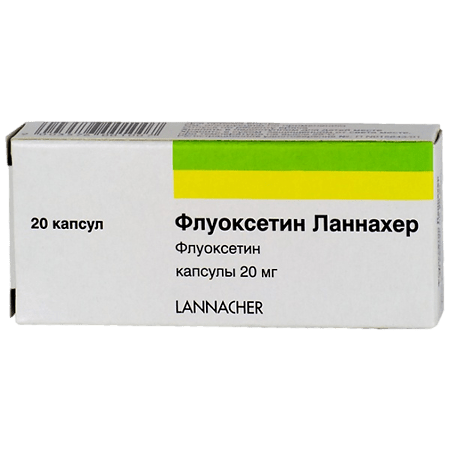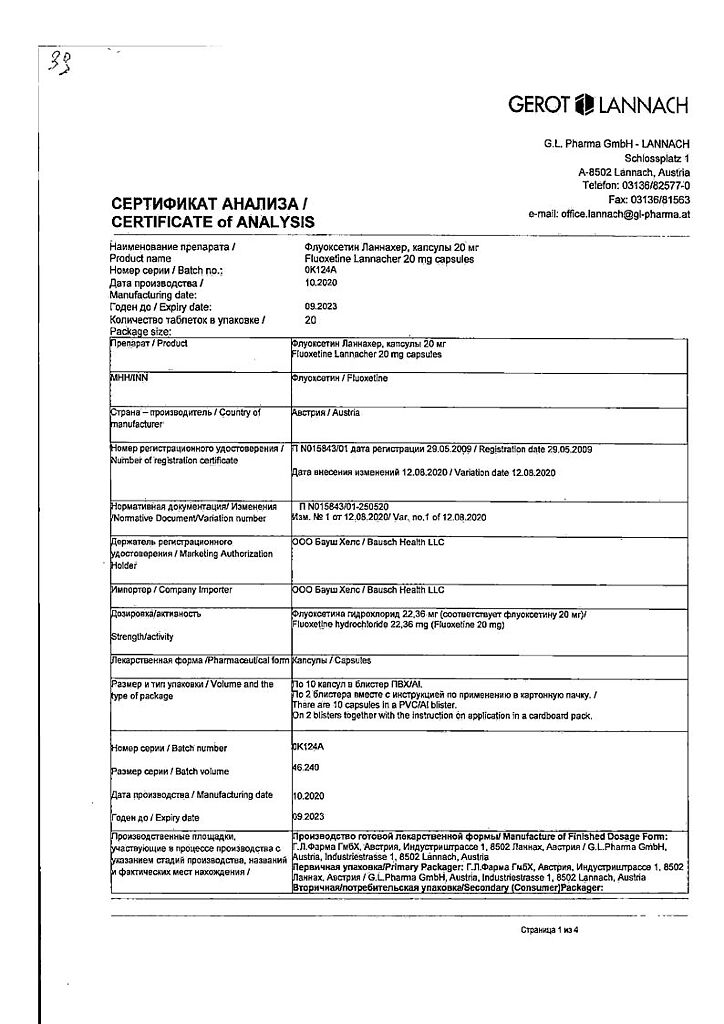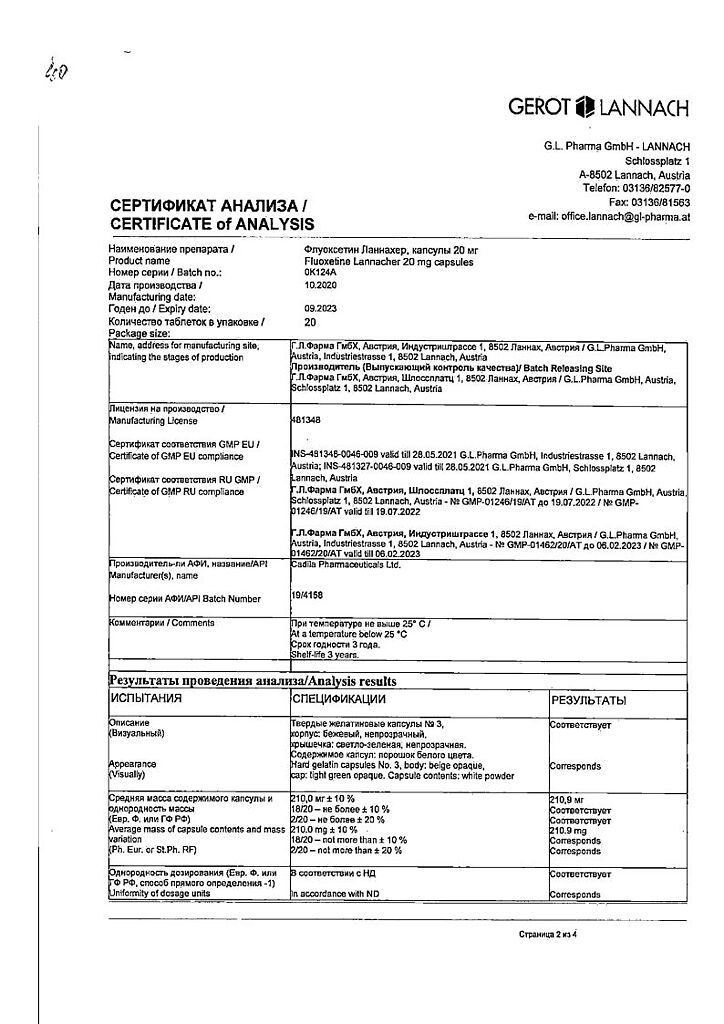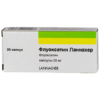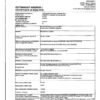No products in the cart.
Fluoxetine Lannacher, 20 mg capsules 20 pcs
€4.12 €3.67
Out of stock
(E-mail when Stock is available)
Description
Fluoxetine has antidepressant, anorexigenic effects.
It selectively inhibits serotonin reuptake, which leads to increase of its concentration in the synaptic cleft, strengthening and prolongation of its action on postsynaptic receptors. Increasing serotonergic transmission by negative feedback mechanism inhibits the metabolism of the neurotransmitter.
In prolonged use it lowers the activity of 5-NT1 receptors. It also blocks serotonin reuptake in platelets. Weakly affects the reuptake of noradrenaline and dopamine. It has no direct effect on serotonin, m-cholinergic, H1-histamine and alpha-adrenoceptors. Unlike most antidepressants it does not cause decrease of activity of postsynaptic beta-adrenoreceptors.
Effective in endogenous depression and obsessive-compulsive disorders. It improves mood, reduces tension, anxiety and feelings of fear and eliminates dysphoria. Has anorexigenic effect, may cause weight loss. In patients with diabetes, it can cause hypoglycemia; when fluoxetine is withdrawn, it can cause hyperglycemia. A pronounced clinical effect in depression occurs after 1-4 weeks of treatment, in obsessive-compulsive disorders – after 5 weeks or more.
When fluoxetine is used during pregnancy, an increased risk of preterm delivery, developmental abnormalities and poor adaptation of newborns (including difficulty breathing, cyanosis, excitability) have been noted.
There is evidence for efficacy of fluoxetine in eating disorders (anorexia nervosa), alcoholism, anxiety disorders, including sociophobia; diabetic neuropathy, affective, including Bipolar disorders; dysthymia, autism, panic attacks, premenstrual syndrome, narcolepsy, catalepsy, obstructive sleep apnea syndrome, kleptomania, schizophrenia, schizoaffective disorders and others.
Indications
Indications
– Depression of various origins.
– Bulimia nervosa.
– Obsessive-compulsive disorders (obsessive states).
Pharmacological effect
Pharmacological effect
Fluoxetine has an antidepressant and anorexigenic effect.
Selectively inhibits the reuptake of serotonin, which leads to an increase in its concentration in the synaptic cleft, strengthening and prolonging its effect on postsynaptic receptors. By increasing serotonergic transmission, it inhibits neurotransmitter exchange through a negative feedback mechanism.
With long-term use, it reduces the activity of 5-HT1 receptors. It also blocks the reuptake of serotonin in platelets. Weakly affects the reuptake of norepinephrine and dopamine. It has no direct effect on serotonin, m-cholinergic, H1-histamine and alpha-adrenergic receptors. Unlike most antidepressants, it does not cause a decrease in the activity of postsynaptic beta-adrenergic receptors.
Effective for endogenous depression and obsessive-compulsive disorders. Improves mood, reduces tension, anxiety and fear, eliminates dysphoria. It has an anorexigenic effect and can cause weight loss. In patients with diabetes mellitus it can cause hypoglycemia, and when fluoxetine is discontinued, it can cause hyperglycemia. A pronounced clinical effect for depression occurs after 1-4 weeks of treatment, for obsessive-compulsive disorders – after 5 weeks or more.
When using fluoxetine during pregnancy, an increased risk of premature birth, developmental abnormalities and low adaptation of newborns (including difficulty breathing, cyanosis, excitability) were noted.
There is evidence of the effectiveness of fluoxetine in eating disorders (anorexia nervosa), alcoholism, anxiety disorders, including social phobia; diabetic neuropathy, affective, incl. bipolar disorders; dysthymia, autism, panic attacks, premenstrual syndrome, narcolepsy, catalepsy, obstructive sleep apnea syndrome, kleptomania, schizophrenia, schizoaffective disorders, etc.
Special instructions
Special instructions
Careful monitoring of patients with suicidal tendencies is required, especially at the beginning of treatment. The risk of suicide is greatest in patients who have previously taken other antidepressants and in patients who experience excessive fatigue, hypersomnia, or restlessness during treatment with fluoxetine.
When treating patients with low body weight, the anorexigenic properties of fluoxetine should be taken into account.
When carrying out electroconvulsive therapy while taking fluoxetine, prolonged epileptic seizures are possible.
The interval between stopping MAO inhibitors and starting fluoxetine should be more than 2 weeks, and between stopping fluoxetine and taking MAO inhibitors – at least 5 weeks.
Impact on the ability to drive vehicles and operate machinery:
Use with caution by vehicle drivers and people whose activities require increased concentration and speed of psychomotor reactions. During treatment you should avoid drinking alcohol.
Active ingredient
Active ingredient
Fluoxetine
Composition
Composition
1 capsule contains:
fluoxetine hydrochloride 22.4 mg, which corresponds to the content of fluoxetine 20 mg.
Excipients:
lactose,
microcrystalline cellulose,
colloidal silicon dioxide (aerosil),
talc,
magnesium stearate.
Capsule composition:
titanium dioxide,
brilliant black,
patent blue,
Ponceau 4R,
azorubine,
gelatin.
Pregnancy
Pregnancy
Contraindicated during pregnancy. During treatment you should stop breastfeeding.
Contraindications
Contraindications
– Hypersensitivity.
– Use of MAO inhibitors (in the previous 2 weeks).
– Hepatic and renal failure (creatinine clearance less than 10 ml/min).
– Epilepsy and convulsive conditions (history).
– Suicidal ideation.
– Diabetes mellitus.
– Atony of the bladder.
– Angle-closure glaucoma.
– Prostate hypertrophy.
– Pregnancy.
– Breastfeeding.
With caution:
– Children’s age (safety and effectiveness have not been established).
– Myocardial infarction, incl. history.
– Cirrhosis of the liver.
– Old age.
– For cardiovascular diseases.
– Insufficiency of liver and/or kidney function.
Side Effects
Side Effects
From the central nervous system: dizziness, headache, sleep disturbances, increased fatigue, asthenia, tremor, agitation, motor agitation, increased suicidal tendencies, anxiety, mania or hypomania.
From the gastrointestinal tract: loss of appetite, taste disturbance, nausea, vomiting, dry mouth or hypersalivation, diarrhea.
Allergic reactions: in the form of skin rash, itching, urticaria, myalgia, arthralgia, fever.
From the genitourinary system: urinary incontinence or retention, dysmenorrhea, vaginitis, decreased libido, sexual dysfunction in men (slow ejaculation).
Other: increased sweating, tachycardia, impaired visual acuity, weight loss, systemic disorders of the lungs, kidneys or liver, vasculitis.
Interaction
Interaction
Incompatible with MAO inhibitors, other antidepressants, furazolidone, procarbazine, because causes serotonergic syndrome (chills, hyperthermia, muscle rigidity, myoclonus, autonomic lability, hypertensive crisis, agitation, tremor, restlessness, convulsions, diarrhea, hypomanic state, delirium, coma. Possible death).
When taken simultaneously with drugs that have a high degree of binding to plasma proteins (oral anticoagulants, oral hypoglycemic agents, cardiac glycosides, etc.), mutual displacement from protein binding is possible with a change in the concentration of the free fraction in the blood, the risk of side effects increases. The risk of bleeding increases while taking warfarin.
Inhibits the biotransformation of drugs metabolized with the participation of the CYP2D6 isoenzyme of cytochrome P450 (tricyclic antidepressants, dextromethorphan, vinblastine, carbamazepine). Extends T1/2 of diazepam, potentiates the effects of alprazolam.
When taken simultaneously, it changes (increases or decreases) the concentration of lithium in the blood plasma, increases the content of phenytoin (before clinical manifestations of its overdose), the level of tricyclic antidepressants (imipramine, desipramine) increases 2-10 times.
Tryptophan enhances the serotonergic properties of fluoxetine (agitation, motor restlessness, and gastrointestinal dysfunction are possible). Incompatible with ethanol.
Overdose
Overdose
Symptoms: nausea, vomiting, anxiety, agitation, hypomania, convulsions and other symptoms of central nervous system excitation.
Treatment: gastric lavage, administration of activated carbon, for convulsions – diazepam.
Storage conditions
Storage conditions
In a place protected from light, at a temperature not exceeding 25 °C
Shelf life
Shelf life
3 years
Manufacturer
Manufacturer
Lannacher, Austria
Additional information
| Shelf life | 3 years |
|---|---|
| Conditions of storage | In a light-protected place, at a temperature not exceeding 25 °C |
| Manufacturer | Lannacher, Austria |
| Medication form | capsules |
| Brand | Lannacher |
Related products
Buy Fluoxetine Lannacher, 20 mg capsules 20 pcs with delivery to USA, UK, Europe and over 120 other countries.

